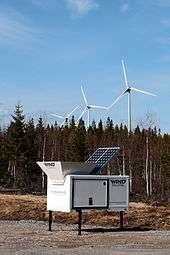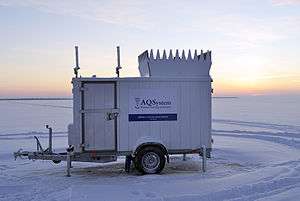SODAR

SODAR (SOnic Detection And Ranging), also written as sodar, is a meteorological instrument used as a wind profiler to measure the scattering of sound waves by atmospheric turbulence. SODAR systems are used to measure wind speed at various heights above the ground, ae thermodynamic structure of the lower layer of the atmosphere.
Sodar systems are like radar (radio detection and ranging) and lidar (light radar) systems except that sound waves rather than radio or light waves are used for detection. Other names used for sodar systems include sounder, echosounder and acoustic radar.[1]
Doppler Sodar
Commercial sodars operated for the purpose of collecting upper-air wind measurements consist of antennas that transmit and receive acoustic signals. A mono-static system uses the same antenna for transmitting and receiving, while a bi-static system uses separate antennas. The difference between the two antenna systems determines whether atmospheric scattering is by temperature fluctuations (in mono-static systems), or by both temperature and wind velocity fluctuations (in bi-static systems).
Mono-static antenna systems can be divided into two categories: those using multiple axis, individual antennas and those using a single phased array antenna. The multiple-axis systems generally use three individual antennas aimed in specific directions to steer the acoustic beam. One antenna is generally aimed vertically, and the other two are tilted slightly from the vertical at an orthogonal angle. Each of the individual antennas may use a single transducer focused into a parabolic reflector to form a parabolic loudspeaker, or an array of speaker drivers and horns (transducers) all transmitting in-phase to form a single beam. Both the tilt angle from the vertical and the azimuth angle of each antenna are fixed when the system is set up.
Phased-array antenna systems use a single array of speaker drivers and horns (transducers), and the beams are electronically steered by phasing the transducers appropriately. To set up a phased-array antenna, the pointing direction of the array is either level, or oriented as specified by the manufacturer.

The horizontal components of the wind velocity are calculated from the radially measured Doppler shifts and the specified tilt angle from the vertical. The tilt angle, or zenith angle, is generally 15 to 30 degrees, and the horizontal beams are typically oriented at right angles to one another. Since the Doppler shift of the radial components along the tilted beams includes the influence of both the horizontal and vertical components of the wind, a correction for the vertical velocity is needed in systems with zenith angles less than 20 degrees. In addition, if the system is located in a region where vertical velocities may be greater than about 0.2 m/s, corrections for the vertical velocity are needed, regardless of the beam's zenith angle.
The vertical range of sodars is approximately 0.2 to 2 kilometers (km) and is a function of frequency, power output, atmospheric stability, turbulence, and, most importantly, the noise environment in which a sodar is operated. Operating frequencies range from less than 1000 Hz to over 4000 Hz, with power levels up to several hundred watts. Due to the attenuation characteristics of the atmosphere, high power, lower frequency sodars will generally produce greater height coverage. Some sodars can be operated in different modes to better match vertical resolution and range to the application. This is accomplished through a relaxation between pulse length and maximum altitude.[2]
Sodar Applications

Traditionally used in atmospheric research, sodars are now being applied as an alternative to traditional wind monitoring for the development of wind power projects. Sodars used for wind power applications are typically focused on a measurement range from 50m to 200m above ground level, corresponding to the size of modern wind turbines. Some sodar products, such as the AQ510 Sodar, have been specifically developed for this market.
Compact-beam sodars are more accurate in complex terrain where the wind vector can change across the measurement area of the sodar. By providing a more compact beam angle, these sodars reduce the effect of any change in the wind vector. This provides a more accurate estimate of wind flow and therefore energy production of a wind turbine. Compact beam sodars also reduce the effect of fixed echos and allow a more compact unit design.
Multiple-axis sodars provide the capability for simultaneous firing of all three sound beams, unlike single-axis sodars which must fire each sound beam sequentially. Simultaneous firing can provide three times the number of sample points in any given period, resulting in a higher signal to noise ratio (SNR), higher data availability and greater accuracy.
Sodars designed for the wind energy industry also differ in important aspects such as the traceability of data as a number of manufacturers do not return full signal and noise spectrum data from the sodar unit, but rather, only return processed wind speed data. This means the raw data cannot be re-analysed or reprocessed.
See also
Notes
- ↑ "About Sodar". Atmospheric Research & Technology, LLC. 2006-03-10. Retrieved 2007-05-08.
- ↑ Bailey, Desmond T. (February 2000) [1987]. "Upper-air Monitoring". Meteorological Monitoring Guidance for Regulatory Modeling Applications (PDF). John Irwin. Research Triangle Park, NC: United States Environmental Protection Agency. pp. 9–9 to 9–11. EPA-454/R-99-005.
References
 This article incorporates public domain material from the United States Government document "Meteorological Monitoring Guidance for Regulatory Modeling Applications".
This article incorporates public domain material from the United States Government document "Meteorological Monitoring Guidance for Regulatory Modeling Applications".
External links
| Wikimedia Commons has media related to Wind profilers. |
- International Society of Acoustic Remote Sensing of the Atmosphere and Oceans
- ARM Climate Research Facility, Radar Wind Profiler
- Fulcrum3D Sodar for wind speed measurements and wind profiling
- Vaisala Triton Wind Profiler, SoDAR for the wind energy industry